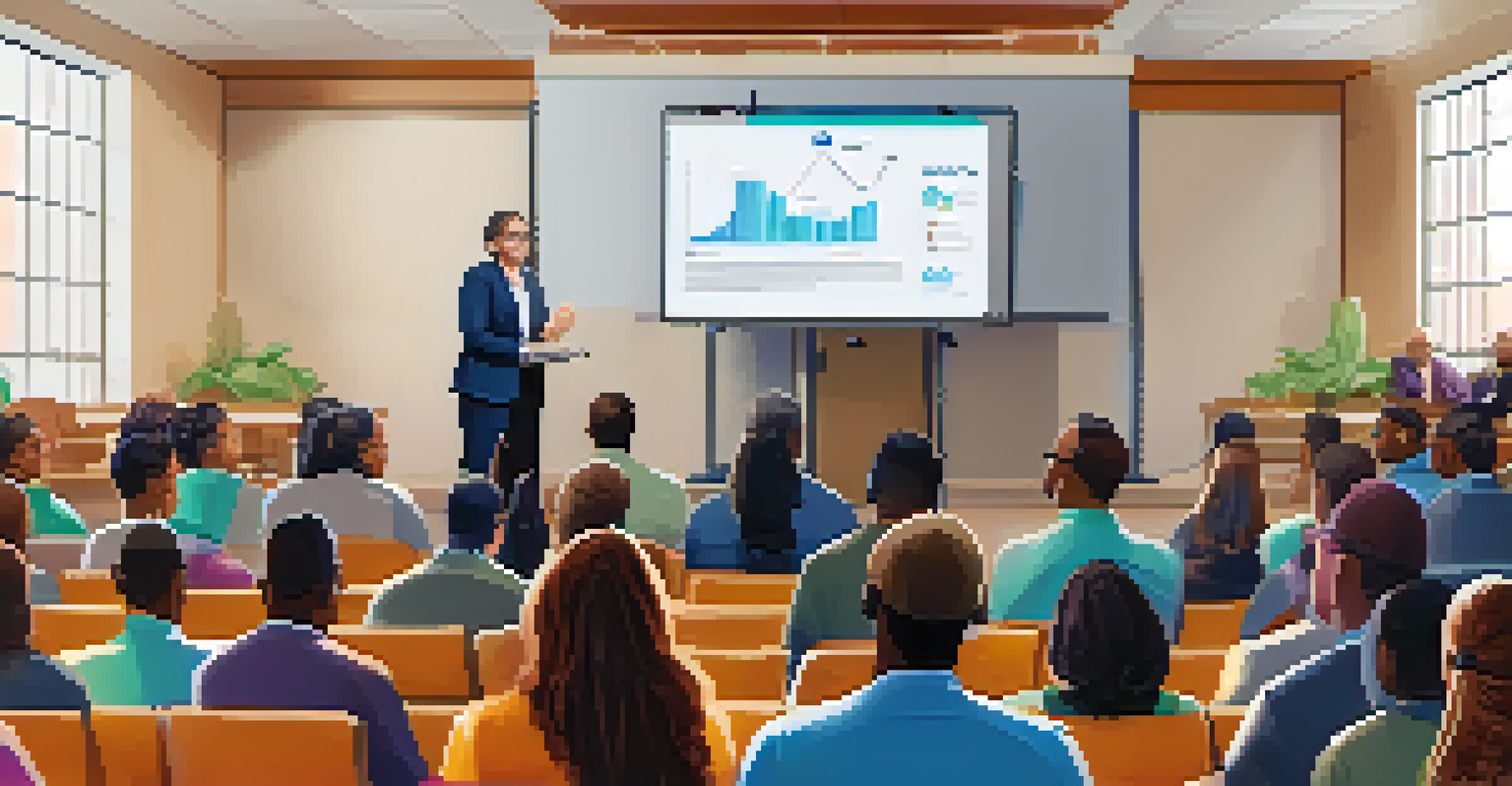Global Education and the Digital Divide: Bridging Gaps

Understanding the Digital Divide in Education
The digital divide refers to the gap between those who have easy access to digital technology and the internet and those who do not. In the context of education, this divide can lead to significant disparities in learning opportunities. For instance, students in urban areas may have access to high-speed internet and advanced technology, while those in rural regions might still rely on outdated resources. This gap not only affects students' immediate learning outcomes but also their future opportunities in an increasingly digital world.
The digital divide is not just about technology; it's about social justice and equity in education.
As education increasingly moves online, the implications of the digital divide become more pronounced. Without internet access, students cannot participate in remote learning, access vital educational resources, or connect with peers and teachers. This situation can lead to feelings of isolation and frustration for students and educators alike. Furthermore, the pandemic has highlighted these disparities, forcing many to confront the harsh reality that not all students are on equal footing.
Addressing the digital divide is essential for creating an equitable education system. It requires collaboration among governments, educational institutions, and technology providers to ensure that all students have access to the necessary tools and resources. By recognizing the importance of digital access, we can begin to envision a more inclusive educational landscape.
The Impact of the Digital Divide on Learning Outcomes
The consequences of the digital divide extend beyond access; they directly impact learning outcomes. Research shows that students without reliable internet access tend to perform worse academically compared to their connected peers. This gap in performance can lead to long-term effects, limiting future educational and employment opportunities. For instance, a student who lacks access to online resources may struggle to complete assignments or participate in collaborative projects, hindering their overall growth.

Moreover, the digital divide amplifies existing inequalities in education. Students from low-income families often face additional challenges, such as inadequate support at home or limited access to educational materials. This situation creates a cycle where those already disadvantaged fall further behind, making it challenging to break the cycle of poverty. Therefore, addressing this divide is not just about technology; it's about social justice and equity in education.
Digital Divide Affects Learning Equity
The digital divide creates significant disparities in educational access and outcomes, particularly impacting students in rural and low-income areas.
To overcome these challenges, innovative solutions are needed. Schools and communities can work together to provide resources like loaner devices and community Wi-Fi hotspots. Additionally, training programs for both educators and students can help bridge the skills gap, ensuring that everyone can effectively leverage technology for learning.
Successful Initiatives to Bridge the Digital Divide
Across the globe, various initiatives aim to bridge the digital divide and improve access to education. For example, programs like One Laptop Per Child provide affordable laptops to children in underprivileged communities, enabling them to participate in the digital age. Similarly, organizations like Khan Academy offer free online educational resources, helping students worldwide gain access to quality learning materials. These initiatives not only provide tools but also inspire a love for learning.
Education is the most powerful weapon which you can use to change the world.
In addition to providing devices, many schools and organizations are focusing on improving internet access. Community networks and partnerships with local businesses can help create reliable Wi-Fi hotspots in underserved areas. This collaboration not only helps students but also fosters community development, ensuring that families can access essential services online.
It's crucial to highlight the importance of sustainability in these initiatives. By investing in long-term solutions, such as training teachers and building infrastructure, communities can create a lasting impact. When students are provided with the necessary resources and support, they can thrive academically and contribute positively to society.
The Role of Government in Closing the Gap
Governments play a pivotal role in addressing the digital divide in education. Policies that prioritize digital access and equity can significantly impact students' learning experiences. For instance, allocating funds to expand broadband infrastructure in rural areas can help ensure that every student has access to the internet. Additionally, initiatives like subsidies for low-income families to obtain technology can make a world of difference.
Beyond funding, government can also facilitate collaboration between various stakeholders, including schools, tech companies, and community organizations. By fostering partnerships, governments can create programs that address the unique needs of different communities. This collaborative approach ensures that resources are allocated where they are needed most, maximizing their impact on education.
Innovative Solutions Bridge Gaps
Successful initiatives like providing affordable devices and community internet access are crucial in narrowing the digital divide in education.
Furthermore, governments can set standards for digital literacy, ensuring that students are not only connected but also equipped to navigate the digital world. By integrating digital skills into the curriculum, students can learn to use technology effectively, preparing them for future challenges. This proactive approach can help bridge the gap and create a more equitable educational landscape.
Empowering Educators to Bridge the Gap
Educators are at the forefront of bridging the digital divide in education. By equipping teachers with the right tools and training, they can effectively integrate technology into their classrooms. Professional development programs that focus on digital literacy and teaching strategies can empower educators to utilize technology in meaningful ways. This not only enhances their teaching methods but also positively impacts student engagement and learning outcomes.
Moreover, educators can serve as advocates for their students, pushing for the resources and support they need. By raising awareness of the challenges posed by the digital divide, teachers can engage parents, community members, and policymakers to take action. This grassroots approach can lead to significant changes within communities, creating a collective effort to support students' educational journeys.
Additionally, fostering a culture of innovation within schools can encourage educators to explore new ways to utilize technology. By allowing teachers the freedom to experiment with different tools and resources, schools can create an environment where creativity thrives. This not only benefits students but also cultivates a sense of community among educators who are all working towards a common goal.
The Future of Global Education in a Digital World
As we look to the future, the importance of bridging the digital divide in global education cannot be overstated. With technology continuing to evolve, it's crucial that we ensure all students have access to the tools and resources they need to succeed. This means investing in infrastructure, training educators, and fostering community partnerships that prioritize equity in education. By addressing these challenges head-on, we can create a more inclusive learning environment for everyone.
Additionally, the future of education will likely see a greater emphasis on blended learning models, combining traditional teaching methods with online resources. This approach allows for personalized learning experiences, catering to the unique needs of each student. However, for this model to be effective, access to technology and the internet must be universal, ensuring that no student is left behind.
Government's Role is Vital
Governments must prioritize digital access and equity through funding, collaboration, and the establishment of digital literacy standards to improve education for all.
Ultimately, the goal should be to create a global education system that empowers all learners, regardless of their background. By working together to bridge the digital divide, we can transform education into a tool for social change, helping to build a brighter future for generations to come.
Call to Action: Bridging the Digital Divide Together
Bridging the digital divide in education requires collective action from all of us. Whether you are an educator, a parent, a policymaker, or a member of the community, your role is crucial in this effort. Start by advocating for resources and support for your local schools, and consider volunteering your time or expertise to help others navigate the digital landscape. Every small action counts and can lead to meaningful change.
Additionally, supporting organizations that focus on closing the digital divide can amplify your impact. Whether through donations, volunteer work, or simply spreading awareness, your involvement can help provide essential resources to those who need them most. Remember, it takes a village to raise a child, and the same holds true for bridging educational gaps.

Lastly, stay informed about the issues surrounding the digital divide and engage in conversations about potential solutions. By fostering dialogue and collaboration, we can create a movement that ensures equitable access to education for all. Together, we can build a future where every student has the opportunity to thrive, regardless of their circumstances.